The theory goes that the pandemic has induced workers to re-evaluate what they want from work with a suggestion that people will no longer put up with bad work. Some are quitting their jobs, while others are quitting work entirely. But what does the evidence suggest?
While some specifics of this article are focused on a UK context, the broader principles and implications should be of interest wherever you are based.
The great suppression
Figure 1 shows the rate of job to job moves. It currently stands at 3.2% which is a record high and therefore evidence of a great resignation. However, when we look at the longer time series it becomes pretty obvious that this record high was preceded by a massive drop. The pandemic had a chilling effect on job to job moves, much like the financial crash did (which is also shown in Figure 1). In uncertain times, sticking with your current employer is a safer bet. This reduction in churn/turnover we might label the great suppression.
Figure 1: job to job moves at a record high
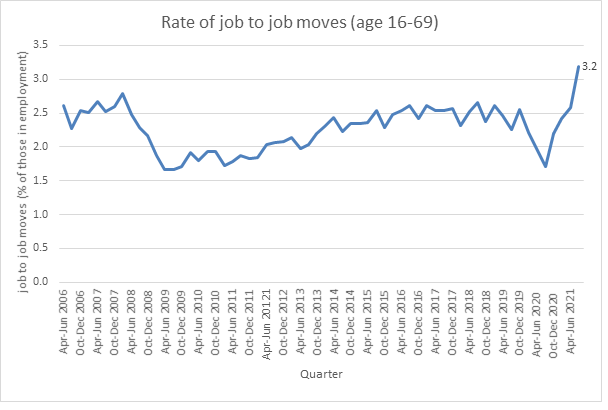
Source: ONS X02, labour market flows SA
The peculiar nature of the pandemic meant that there were further reasons not to look for a new job.
- Getting a new job could make people ineligible for furlough in event of new restrictions (which invariably did happen).
- During the initial stages of the pandemic, job vacancies fell across the board - Figure 2. As business confidence was hit, people’s prospects for work diminished. In fact, the unemployment rate may have been kept lower because people were not looking for work. Someone is only technically unemployed if they are available and looking for work, otherwise, they are counted as ‘inactive’. With whole sectors of the economy temporarily switched off it was much more difficult to look for work.
Figure 2: Job adverts fell across the board when Covid-19 hit
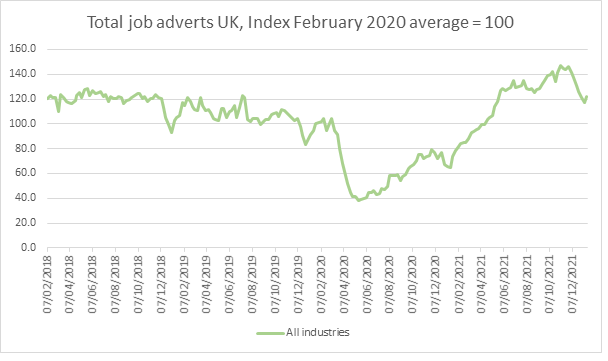
Source: Online job advert estimates from Adzuna via ONS
These effects can be seen in hospitality - Figure 3. The average tenure of the industry increased as employers used furlough to hoard labour and churn/turnover in the industry reduced. Opportunities for progression were curtailed externally as there were fewer jobs to move to, and internally as fewer people moved on. Many employees who bided their time during the pandemic are now looking to make up for that lost progression (also Figure 3 where tenure is shooting back down again as people quit their jobs) and the reopening of these sectors provided the perfect conditions for moving jobs.
Figure 3: The pandemic caused average tenure in hospitality to increase
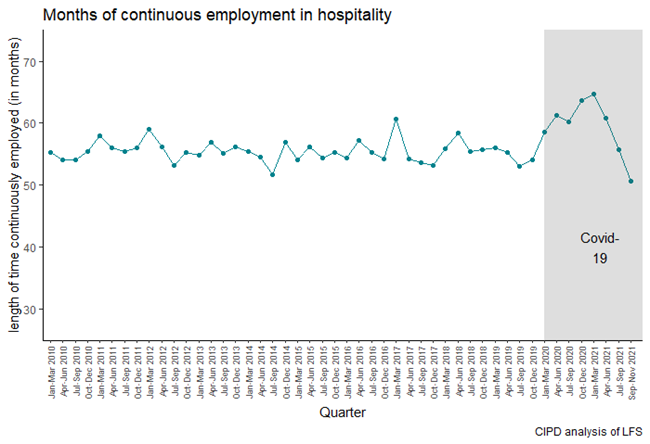
The great unbunching
The end of furlough on 30th Sep 2021 (and therefore the end of risky job moves) coincided with a boom in vacancies (above pre-pandemic levels - Figure 2). As the economy reopened many employers struggled to meet demand and recruit enough workers. Now came the great unbunching, as all that turnover/churn that was suppressed during the pandemic was let loose, encouraged by the tailwinds of high vacancies and low unemployment. In fact, the ratio of unemployed, for every available job is now at a record low of 1.1 - Figure 4.
Figure 4: There are fewer people unemployed for each available job now
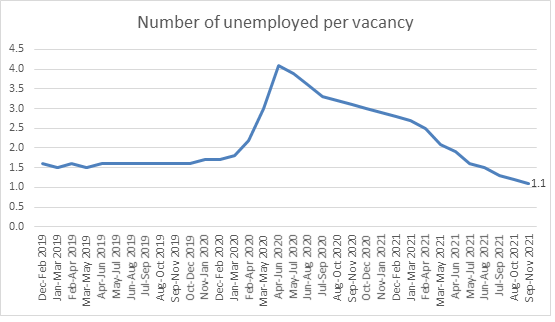
Source: ONS - VACS01: Vacancies and unemployment
But the great resignation is not just about the unemployed. It’s about those in work deciding to leave their current employer.
Are employees getting itchy feet? The great retention
Employees are not looking for a new job in greater numbers – Figure 5. There was an obvious drop in job seeking during the pandemic, followed by a recovery, but it remains below pre-pandemic levels. This indicates the opposite of the great resignation. A great retention. The chart suggests that employees actually seek new jobs in times of high unemployment when they are less well matched to their jobs. At such times for example we tend to see higher numbers of graduates in non-graduate jobs. These employees will be looking to trade up.
Figure 5: People in employment are not seeking a new job at higher rates
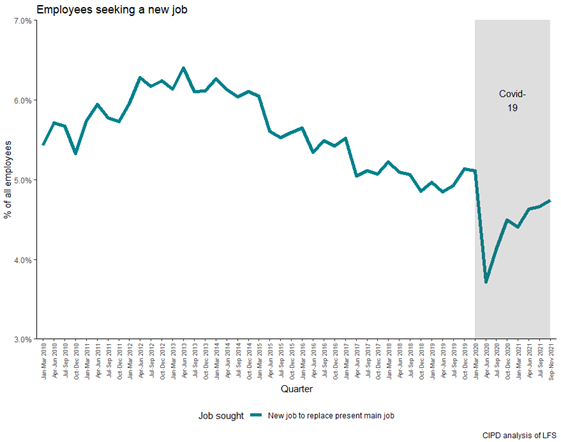
When we look at the reason that people changed jobs, we can see that dismissals and redundancies were very prominent during the pandemic but have since declined - Figure 6. Resignations are now growing and stood at about 40% more (in absolute terms) than pre-pandemic. Could this be evidence of the great rethinking of priorities? The increase in resignations may seem to contradict Figure 5 which showed that fewer people in work are looking for new jobs, but it does not necessarily. Although employees may not be looking for a job, when they do look (or are contacted by a recruiter), they are much more likely to actually get a new job. So, we can have both low rates of people looking for/wanting a new job, and high rates of people getting a new job at the same time.
Figure 6: Job movers are more likely to resigning now
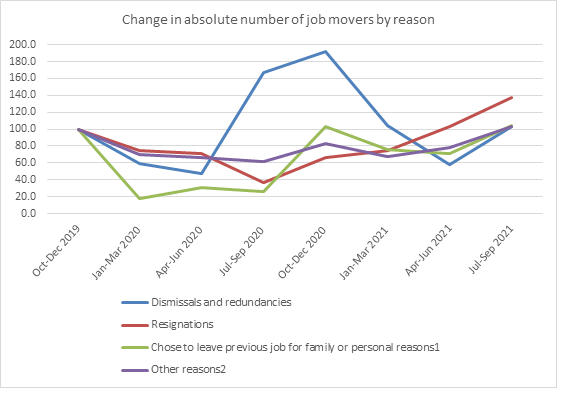
Source: ONS X02, Total job to job moves by reason for a job move
The decrease in redundancies is worth looking at further. Although recruitment and vacancies tend to grab the headlines, employers are increasingly focusing on the retention of existing employees. They are incentivised by the tight labour market (low unemployment and few candidates) to look after the incumbent workforce because it’s so much harder to bring in new people. We are seeing, for example, the lowest redundancy rate on record – Figure 7.
Figure 7: The redundancy rate is at an all-time low
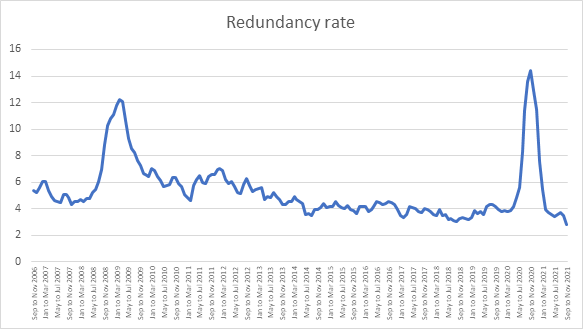
Source: ONS January labour market statistics, redundancy rare. Notes: Redundancy rate is the ratio of the redundancy level to the number of employees in the previous quarter, multiplied by 1,000.
Labour market participation
Another piece of the puzzle is the change in labour market participation during the pandemic. There are fewer people in the labour force now than pre-pandemic. Some of these are immigrants who have returned to their home countries. Another source is UK national workers who are now economically inactive. It appears that most of the increase in inactivity is voluntary, as people are registering that they are inactive but do not want to work. This could be evidence of a great resignation.
Figure 8: many inactive workers do not want a job
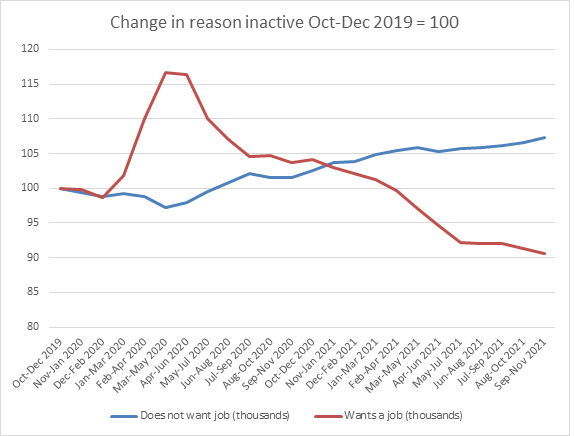
Source: ONS, Table INAC01: Economic inactivity
Previous recessions have also led to an early exit from the labour market. As this IFS report on retirement in the 21st-century notes:
“The recessions of the early 1980s and (to a lesser extent) the early 1990s had a particularly large and lasting effect on the employment of older men…..they dropped particularly sharply during the recession of the early 1980s…. Employment rates for older men did not return to their previous levels after either recession, suggesting that – once they left work – older men were less likely to have returned to work and more likely to be absorbed into unemployment, sickness or early retirement.” (For a more extensive exploration of the increase in labour market participation among the older workforce, see Chandler, D. and Tetlow G. (2014) Retirement in the 21st century. Institute for Fiscal Studies.)
This might prompt us to ask, is the great resignation (of an early exit from work) a covid recession phenomenon or simply just a recession phenomenon?
And a final thought
The way we live and work changes as we get older. People usually transition through stages such as education, employment, inactivity and eventually retirement - Figure 9. But the major disruption of the pandemic has interfered with these transition points. Perhaps they came sooner and were much more discrete than they might have been in smoother economic times. We have seen record numbers of young people attending higher education and an increase in an early exit from the workforce. The sheer length of the pandemic and its disruption puts a lot of open water between the pre and post-pandemic world of work making the disjoint seem starker.
Figure 9: Economic activity across the lifecycle
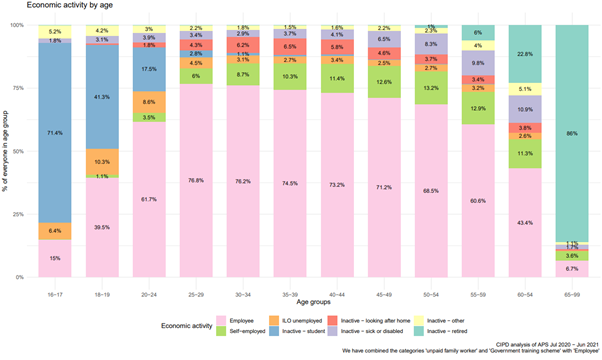
Great resignation, fact or fiction?
There is some evidence for a great resignation. The theory that the pandemic has shifted preferences around the type of work people want to do holds less water. Rates of job-to-job moves can be explained by the dynamics of furlough ending and the economy reopening. A combination of suppressed churn/turnover and a tight labour market. High rates of exit from the labour market, particularly for older workers, are not unusual in a recession.
Whether or not there is a great rethink is less important. The challenges for employers and policymakers are the same. Recruitment is difficult right now and that may be holding back the recovery. Creating quality work with lots of flexibility will help employers attract, and crucially retain employees. This is particularly important for older workers who value flexibility, especially around hours worked. There has also been a large increase in inactivity due to sickness and ill-health. Providing early access to occupational health services, for example, on day one of absence to workers who have recurrent or long-term health conditions, is the most effective way of treating such problems and preventing them from worsening. Employers must also ensure managers can facilitate the provision of reasonable adjustments for those with a disability or long-term health condition.
The high churn and record vacancies experienced in recent months should die down soon. Longer-term skills shortages will remain. Here policymakers should look to the skills system. Employers can only reverse the decline in investment in training with the right incentives which the apprenticeship levy has thus far failed to do. The levy needs reforming to give employers more flexibility to accredit other forms of training and skills development that suit them.
Topics A-Z
Browse our A–Z catalogue of information, guidance and resources covering all aspects of people practice.
Bullying
and harassment
Discover our practice guidance and recommendations to tackle bullying and harassment in the workplace.
About the author

Jon Boys, Labour Market Economist
Jon joined the CIPD in January 2019 as an Economist. He is an experienced labour market analyst with expertise in pay and conditions, education and skills, and productivity.
Jon primarily uses quantitative techniques to uncover insights in labour market data, both publicly available and generated through in house surveying. Jon regularly contributes commentary and analysis of economic issues on the world of work to online, print and TV media. Recent work includes the creation of an international ranking of work quality, analysis of firm level gender pay gap reporting data, and an ongoing programme of work looking at the changing age profile of the UK workforce.

Explore the CIPD’s point of view on employee voice, including recommendations for employers

Evaluating the pros and cons of working in shared office spaces, and how they impact on productivity

An examination of how strong channels for employee voice has the potential to drive the effectiveness of high-performance management practices

Researchers explore the differences between ‘organisational’ and employee-focused voice, how they impact employees and what managers can do to foster voice

Peter Cheese, the CIPD's chief executive, looks at the challenges and opportunities faced by today’s business leaders and the strategic priorities needed to drive future success

We outline the key pieces of legislation set to come into force in the UK and explain their implications for employers and employees

We examine people’s desired hours and how this compares to the hours they actually work

Employers’ reactions to pension proposal highlight concerns over cost, while the CIPD calls for focus on raising pension awareness among staff, the need for higher contributions and better understanding of value for money